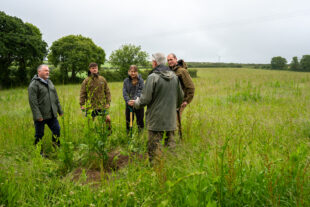https://defrafarming.blog.gov.uk/create-and-maintain-flower-rich-margins-and-plots/
Create and maintain flower-rich margins and plots
The guidance on this page is for SFI pilot participants only. Please visit GOV.UK for the official Sustainable Farming Incentive scheme guidance.
Find out how land managers can sow wildflowers to provide food, shelter and nesting places for invertebrates and birds, and protect water bodies.
If you’re completing this action as part of the Sustainable Farming Incentive pilot, how you do it is up to you.
The advice on this page can help you get better environmental and business benefits, but you do not have to follow it to get paid.
Flower-rich margins and plots
Flower-rich margins and plots are permanent areas of flowers and grass. They can be:
- a block in a field
- margins along the edge of a field
- next to water bodies
You can create flower-rich margins and plots on arable land or on existing grass margins or plots. It can take up to 18 months to establish them, but they’re easy to manage and long-lasting
Flower-rich margins and plots provide:
- pollen and nectar for a range of invertebrates like bees and butterflies
- habitats for pollinators such as hover flies that feed on pests like aphids
- shelter and invertebrate food for farmland birds and their chicks
- seed food for farmland birds in autumn and winter
- buffering for waterbodies when planted next to them
Choose the right location
The best locations are:
- sunny
- low in soil fertility and phosphate, as grasses and weeds can dominate fertile areas
- next to hedges, ditches and water bodies to provide wildlife with a range of habitats
Space your margins and plots as evenly as you can across your land. Pollinators will use them as stepping stones. For example, 5 evenly spaced margins or plots will allow pollinators to move across 100 hectares (ha) of farmland.
Avoid sites that:
- have persistent weed problems, as flowers won’t have space to grow
- have rare arable wildflowers, as they need cultivation to thrive
- are shady, as this can lead to poor establishment
- are remote or difficult for you to access and manage
- you use for regular machinery access, turning or storage
Do not drive on margins or use them as tracks or access routes if you’re using them as part of the water body buffering standard. Plan access for essential maintenance to minimise disturbance to the margin.
How to establish flower-rich margins and plots
Margins and plots need to be at least 0.25ha and 4 metres wide.
You can create flower-rich margins or plots by:
- natural regeneration
- sowing seeds
- spreading green hay
Using natural regeneration or green hay means the flowers in your margin or plot are local to your area. They are cheaper than sowing a seed mix but take longer to establish.
Do not sow a seed mix next to valuable botanical sites, like Sites of Special Scientific Interest (SSSI). This can cause cross pollination of sown species with natural plant communities.
You’ll need to sow a seed mix for flower-rich margins or plots next to water bodies. A seed mix establishes more quickly and reduces the risk of soil erosion, which can damage freshwater habitats.
When to establish flower-rich margins and plots
Sow a seed mix between March and mid-September when the soil temperature is above 7°C and there is available soil moisture.
Wildflowers can grow slowly. To avoid frost damage to young plants, sow the mix by the end of August.
You should collect and spread green hay between June and the end of August, when most wildflowers are setting seed.
For natural regeneration, cultivate between spring and late summer.
Create your seedbed
Create a well-consolidated, firm, fine, level and weed-free seedbed before establishing to improve germination. This is the most effective weed and slug control method.
Remove any soil compaction. Do not use a subsoiler if there are historic features present.
You can roll seedbeds before sowing if they are uneven after secondary cultivations.
Natural regeneration
Cultivate and let the wildflower seeds already in the soil germinate.
Natural regeneration is most likely to be successful where:
- the land has been in arable for less than 20 years
- the margin or plot is next to an existing wildflower habitat
Using green hay
You can use green hay from a nearby species-rich grassland.
The donor site needs to be big enough to supply your margin or plot. As a guide, a hay cut from 1ha is enough for a 3ha margin or plot.
Find out how to collect green hay.
Spread the hay across the margin or plot. The seeds will shed and scatter on the bare soil.
Roll or use livestock to trample in seed and ensure good seed-to-soil contact.
Using a seed mix
Choose a seed mix that contains at least:
- 10 native flower species
- 10% by weight of flowers
- 4 native grass species
The minimum seed rate for flowers in the mix is 2kg per hectare.
Your mix should contain an even mix of flower species, with no one flower species exceeding 25% by weight of the mix. A varied mix of flowers will benefit the most invertebrates.
To attract a variety of wildlife, include species:
- with flowers of different shapes, scent and colour
- that flower at different times
- with a long flowering period, like common knapweed, musk mallow and yarrow
Choose fine-leaved grasses like fescues, as they will not shade out flowers.
Your seed supplier can help you choose a seed mix and seed rate to best match your land and local conditions.
Suitable wildflower species
Suitable flowers for flower-rich margins and plots include:
- bird’s foot trefoil
- common knapweed
- cowslip
- ox-eye daisy
- red clover (early and late flowering)
- yellow rattle
Suitable wildflower species for water body buffers
Suitable wildflowers for flower-rich margins next to water bodies include:
- yarrow
- ribwort plantain
- black knapweed
- red campion
- wild carrot
- teasel
- bird’s-foot trefoil (keep below 10% of total mix)
- red clover (keep below 10% of total mix)
- vetch (keep below 10% of total mix)
Suitable grass species
Suitable grasses for flower-rich margins and plots include:
- common bent
- crested dog’s tail
- rough stalked meadow grass
- slender red fescue
- sheep’s fescue
- smaller cat’s tail
How to sow a seed mix
Scatter or shallow-drill seeds into bare ground.
Seeds germinate best when scattered on the surface. Shallow drill no deeper than 1cm. Small seeds struggle to germinate when sown deeper than 1cm.
Roll after sowing to keep in moisture and ensure good seed-to-soil contact.
Mix the seed in the hopper immediately before sowing to prevent an uneven spread of species.
Over-sowing
You can sow flowers into an existing grass margin or plot. Use a seed mix which only contains flower species. You should:
- Control weeds in the spring or early summer.
- Cut the existing grass as short as possible in July and remove all cuttings.
- Harrow to create at least 50% bare ground.
- Scatter or shallow drill seed no deeper than 1cm.
- Roll to keep in moisture, ensure good seed-to-soil contact.
How to manage flower-rich margins and plots
Year 1
Cut 3 to 5 times in the first year. This controls annual weeds and encourages seedling growth. Cut whenever weeds are just above the sown species, before they smother them.
If you have used natural regeneration it may take longer to control weeds. You may need to continue cutting 3 to 5 times a year for 2 years or more.
Year 2 onwards
You need to manage flower-rich areas by either cutting, grazing or a mix of both. This stops grasses dominating, removes nutrients and clears dead material.
Do not graze the margins or plots if you’re using them in the water body buffering standard.
Cut or graze from mid-August so the vegetation is between 10cm and 20cm tall.
Avoid cutting or grazing all your margins or plots at the same time. Staggered cutting or grazing means that there are always flowers available for invertebrates.
Leave up to 10% of each margin or plot uncut or ungrazed each year. This provides a refuge for insects and other wildlife over winter.
Cutting
Remove cut vegetation where possible to:
- reduce the risk of it smothering flower species
- remove nutrients, which stops weeds and grasses from taking over
You can leave small amounts of finely chopped cuttings if it’s not practical to remove them. Spread cuttings as thinly as possible. A heavy-duty flail will chop up the vegetation and allow it to rot quicker.
Birds, nests and eggs are protected by law. You must check the margin or plot before cutting. If you see signs of nesting birds, delay cutting until birds fledge.
Grazing
Grazing can improve vegetation structure. Livestock will create bare ground and gaps for flowers to spread.
Do not allow livestock to:
- graze between November and the end of February, as this can poach the margin or plot and lead to overgrazing
- supplementary feed on the margin or plot
- graze flower-rich margins and plots that you’re using in the water body buffering standard
Early cutting or grazing
Once every 3 years, you can cut or graze between mid-May and mid-June.
You can cut or graze up to a third of the total area of flower-rich margins and plots on your land. Cut or graze the remaining two thirds from mid-August, as normal.
Early cutting or grazing benefits a wider range of invertebrates as it:
- can extend the flowering period
- creates a range of different vegetation heights
- creates space for seeds to germinate and grow
- can help control weeds
Fertiliser
Do not add fertiliser or manure.
Weed control
To control weeds like docks, nettles, thistles and common ragwort, you can:
- spot treat with herbicide using a knapsack sprayer, hand-lance or weed wiper
- repeatedly cut the affected area
- remove weeds by hand before they have finished flowering
You can cut once every 3 years between October and March to control scrub.
If grasses are preventing flower growth, cut and remove vegetation more often. You can consider using a graminicide if cutting does not work.
What a good flower-rich margin or plot looks like
You’ll see:
- a wide variety of flowers from March through to September
- pollinators and beneficial insects using the flowers
- farmland birds like yellowhammer and skylark feeding on seeds through autumn and winter
- an open sward with some bare ground
- vegetation of different heights



